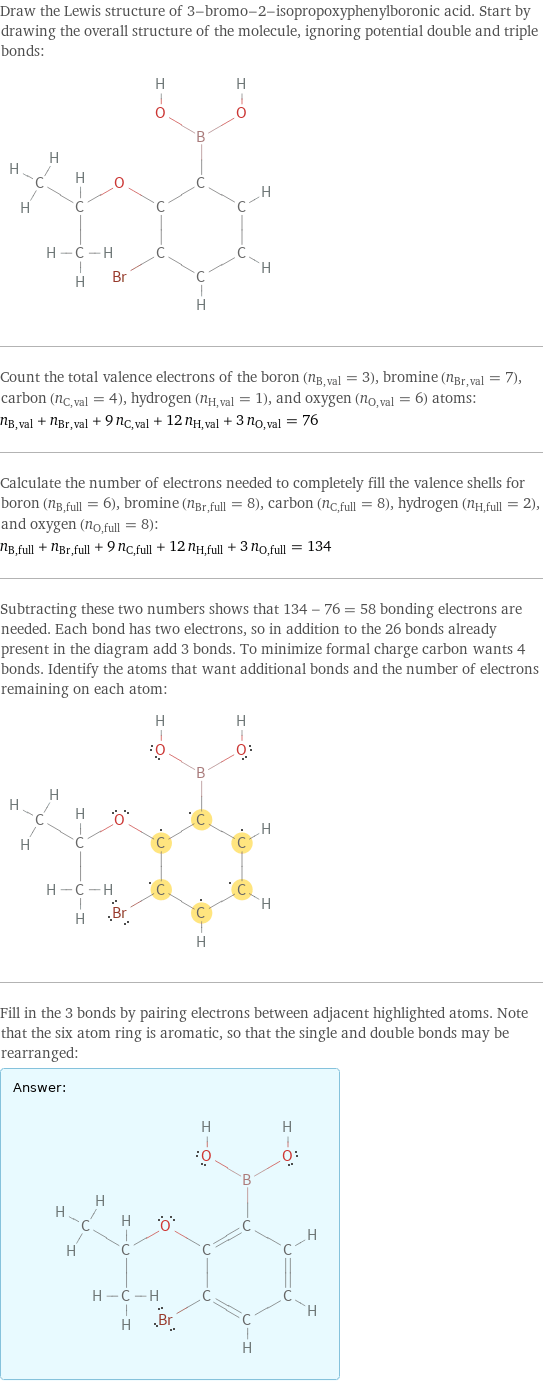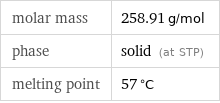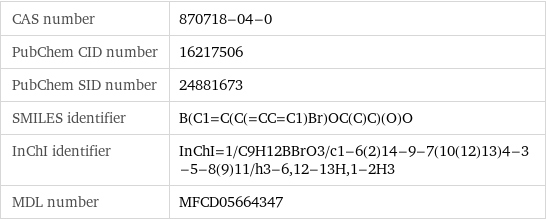Input interpretation

3-bromo-2-isopropoxyphenylboronic acid
Chemical names and formulas

formula | C_9H_12BBrO_3 name | 3-bromo-2-isopropoxyphenylboronic acid IUPAC name | (3-bromo-2-isopropoxyphenyl)boronic acid alternate names | (3-bromo-2-isopropoxy-phenyl)boronic acid | (3-bromo-2-propan-2-yloxy-phenyl)boronic acid | (3-bromo-2-propan-2-yloxyphenyl)boronic acid mass fractions | B (boron) 4.18% | Br (bromine) 30.9% | C (carbon) 41.8% | H (hydrogen) 4.67% | O (oxygen) 18.5%
Lewis structure

Draw the Lewis structure of 3-bromo-2-isopropoxyphenylboronic acid. Start by drawing the overall structure of the molecule, ignoring potential double and triple bonds: Count the total valence electrons of the boron (n_B, val = 3), bromine (n_Br, val = 7), carbon (n_C, val = 4), hydrogen (n_H, val = 1), and oxygen (n_O, val = 6) atoms: n_B, val + n_Br, val + 9 n_C, val + 12 n_H, val + 3 n_O, val = 76 Calculate the number of electrons needed to completely fill the valence shells for boron (n_B, full = 6), bromine (n_Br, full = 8), carbon (n_C, full = 8), hydrogen (n_H, full = 2), and oxygen (n_O, full = 8): n_B, full + n_Br, full + 9 n_C, full + 12 n_H, full + 3 n_O, full = 134 Subtracting these two numbers shows that 134 - 76 = 58 bonding electrons are needed. Each bond has two electrons, so in addition to the 26 bonds already present in the diagram add 3 bonds. To minimize formal charge carbon wants 4 bonds. Identify the atoms that want additional bonds and the number of electrons remaining on each atom: Fill in the 3 bonds by pairing electrons between adjacent highlighted atoms. Note that the six atom ring is aromatic, so that the single and double bonds may be rearranged: Answer: | |
Basic properties

molar mass | 258.91 g/mol phase | solid (at STP) melting point | 57 °C
Units

Chemical identifiers

CAS number | 870718-04-0 PubChem CID number | 16217506 PubChem SID number | 24881673 SMILES identifier | B(C1=C(C(=CC=C1)Br)OC(C)C)(O)O InChI identifier | InChI=1/C9H12BBrO3/c1-6(2)14-9-7(10(12)13)4-3-5-8(9)11/h3-6, 12-13H, 1-2H3 MDL number | MFCD05664347
Safety properties

flash point | 110 °C